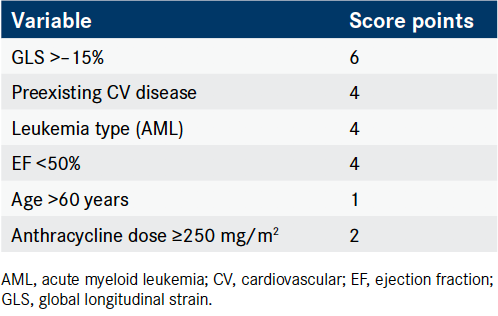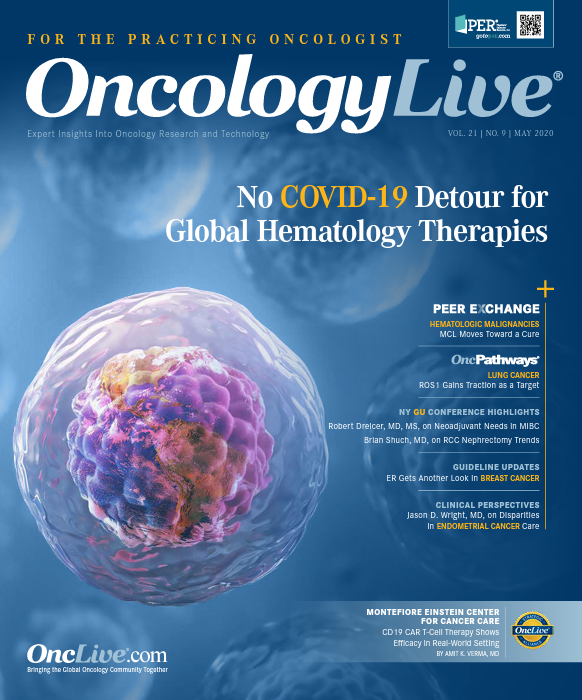Scoring System Stratifies Risk of Heart Failure in Patients With Acute Leukemia
Baseline clinical characteristics coupled with measurable cardiac parameters can be used to predict the risk of heart failure among adults with acute leukemia who receive anthracycline-based therapy, according to recent study findings.
Marielle Scherrer- Crosbie, MD, PhD

Baseline clinical characteristics coupled with measurable cardiac parameters can be used to predict the risk of heart failure (HF) among adults with acute leukemia who receive anthracycline-based therapy, according to recent study findings.1
Investigators developed a 21-point scoring system to evaluate the potential for HF among patients with newly diagnosed acute myeloid leukemia (AML) or acute lymphoblastic leukemia (ALL). The formula stratifies patients into high-, moderate-, or low-risk groups.
Although prior research has shown that patients with hematologic malignancies experience the highest rates of symptomatic HF and cardiac death compared with other patients with cancer treated with anthracyclines, investigators said data are limited when it comes to evaluating comorbidities in those with acute leukemia.
“While we are more effective at treating cancer, the improved survival rates have helped to unmask the cardiotoxic impact of some of the most common cancer therapies,” study coauthor Marielle Scherrer-Crosbie, MD, PhD, said in a statement.2
“Our hope, in creating this risk score system, is to help clinicians identify patients with the highest risk for potential cardiac damage, so they can more closely monitor the patients via a multidisciplinary approach,” said Scherrer-Crosbie, director of the Cardiac Ultrasound Laboratory and a professor of cardiovascular (CV) medicine in the Perelman School of Medicine at the University of Pennsylvania in Philadelphia.
To examine these factors, investigators identified adults (≥18 years of age) treated with anthracyclines for newly diagnosed AML or ALL at the Hospital of the University of Pennsylvania between January 2004 and April 2018. In all, 450 patients with adequate baseline records who were followed for a median of 16 months (range, 1-132 months) were included in the analysis. The description of symptomatic HF was based on the 2017 Cardiovascular and Stroke Endpoint Definitions for Clinical Trials.
Among those in the study, symptomatic HF developed in 8.9% of the patients (n = 40), which included 1 patient with decompensated HF who died. The median time to development of HF was 10 months (range, 1-76). Death due to a noncardiac cause occurred in 47.8% of patients (n = 215).1
At baseline, 67% of patients in the study had AML (n = 301) and 33% had ALL (n = 149). Forty-eight percent of patients were male (average age, 51 years; ± 15). The most common baseline CV disease characteristics were current/previous smoking history (40%), having 2 or more CV risk factors (39%), hypertension (36%), and hypercholesterolemia (22%).
Investigators found that patients who developed HF were typically older and had a higher incidence of previous HF, atrial fibrillation, and preexisting CV diseases.
Risk Score Comprises 6 Values
The scoring system assigns point values to 6 factors: baseline global longitudinal strain greater than –15%, left ventricular ejection fraction less than 50%, preexisting CV disease, AML, anthracycline dose of 250 mg/m2 or greater, and age greater than 60 years (Table).1 Patients were then divided by scores into low (0-6 points), moderate (7-13 points), and high (14-21 points) risk groups.
Overall, the 1-year estimated cumulative incidence of HF for the low-, moderate-, and high-risk groups was 1.0%, 13.6%, and 35.0%, respectively.
The risk of HF and noncardiac mortality was found to be higher in patients with AML (11.6% and 52.8%, respectively) than in those with ALL (3.4% and 34.9%; P <.001). Contributing factors to this finding included greater doses of anthracyclines in patients with AML and that patients in the AML group tended to be older. After adjusting for these risk factors, however, patients with AML still faced a greater risk of symptomatic HF (HR, 2.77; 95% CI, 1.01-7.63; P = .048).
Table. Variables Included to Predict the Risk of Heart Failure After Leukemia Therapy1

For patients with ALL, investigators modified the risk score to exclude an AML diagnosis. Using a 17-point formula, investigators estimated the cumulative risk of HF incidence at 1 year in patients with ALL at less than 0.1% for the low-risk group, 3.6% for the moderate-risk group, and 17.0% for the high-risk cohort (P <.001).
An exploratory analysis was also conducted to show the relationship between risk score and overall mortality. It was discovered that the risk score was associated with all-cause death (HR, 1.36; 95% CI, 1.23-1.50; P <.001). Patients in low-risk to moderate-risk groups had a greater overall survival time than high-risk patients (P <.001). Only global longitudinal strain greater than –15% was found to be independently related to all-cause death (HR, 1.73; 95% CI, 1.30-2.31; P <.001).
Limitations of the study include the fact that it was conducted at a single center and that the score has not been validated in a separate cohort, investigators said. A large prospective, multicenter study is needed to further validate the formula.
References
- Kang Y, Assuncao BL, Denduluri S, et al. Symptomatic heart failure in acute leukemia patients treated with anthracyclines. JACC: CardioOncology. 2019:1(2):208. doi:10.1016/j.jaccao.2019.10.008
- Patients with acute leukemia who are treated with common therapy have increased risk for heart failure. New release. Philadelphia, PA: Penn Medicine; December 17, 2019. Accessed March 16, 2020. https://bit.ly/2w3mjPA




